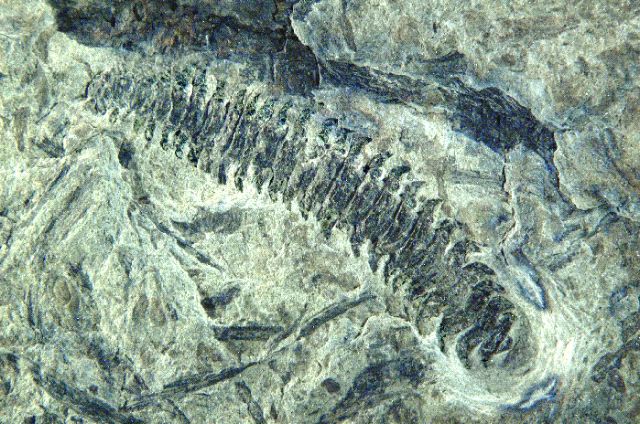Zanclodesmus
Among the dead leaves of Archaeopteris and other organic debris that covered the soil of the Miguasha ecosystem, tiny millipedes evolved and undoubtedly played their role of decomposers.
 (100 kb) Discovered in October 2003, the millipede Zanclodesmus willetti made its mark as a new terrestrial animal among the Miguasha fauna. The honour of this lucky discovery goes to park warden Jason Willett, for whom the species was named.
(100 kb) Discovered in October 2003, the millipede Zanclodesmus willetti made its mark as a new terrestrial animal among the Miguasha fauna. The honour of this lucky discovery goes to park warden Jason Willett, for whom the species was named.
The finding led to the creation of a new family of primitive millipedes, the zanclodesmids, which includes a close cousin, Orsadesmus, recently discovered in the Catskill Formation of Pennsylvania. Specimens of this arthropod family are rare and restricted to the North American portion of the Old Red Sandstone.
Both species are a few centimetres long with flattened backs, and each body segment is flanked by lateral projections that curve toward the rear. Other millipede fossils of this type have been found in the Siluro-Devonian formations of Scotland’s Midland Valley. This transoceanic distribution is reasonable considering that North America and northwestern Europe shared the same sedimentary domain—that of the Old Red Sandstones—in the ancient continent of Euramerica. Of significant note, some researchers believe that millipedes were the first animals to have conquered land during Silurian time.
Zanclodesmus is a tiny gem of preservation. Approximately 44 mm long, the specimen displays 27 segments and its head as seen from above. Some of the feet are visible, as are its antennae and eyes. The latter comprise several large ocelli, like those of many land-dwelling arthropods today.

 (100 kb) Discovered in October 2003, the millipede Zanclodesmus willetti made its mark as a new terrestrial animal among the Miguasha fauna. The honour of this lucky discovery goes to park warden Jason Willett, for whom the species was named.
(100 kb) Discovered in October 2003, the millipede Zanclodesmus willetti made its mark as a new terrestrial animal among the Miguasha fauna. The honour of this lucky discovery goes to park warden Jason Willett, for whom the species was named.The finding led to the creation of a new family of primitive millipedes, the zanclodesmids, which includes a close cousin, Orsadesmus, recently discovered in the Catskill Formation of Pennsylvania. Specimens of this arthropod family are rare and restricted to the North American portion of the Old Red Sandstone.
Both species are a few centimetres long with flattened backs, and each body segment is flanked by lateral projections that curve toward the rear. Other millipede fossils of this type have been found in the Siluro-Devonian formations of Scotland’s Midland Valley. This transoceanic distribution is reasonable considering that North America and northwestern Europe shared the same sedimentary domain—that of the Old Red Sandstones—in the ancient continent of Euramerica. Of significant note, some researchers believe that millipedes were the first animals to have conquered land during Silurian time.
Zanclodesmus is a tiny gem of preservation. Approximately 44 mm long, the specimen displays 27 segments and its head as seen from above. Some of the feet are visible, as are its antennae and eyes. The latter comprise several large ocelli, like those of many land-dwelling arthropods today.
Site map | Feedback | Links | Sources | Credits
Zanclodesmus
<< Land-based communities | Petaloscorpio >>



